Mass Spectrometry Analysis and Biological Characterization of the Predatory Ant Odontomachus monticola Venom and Venom Sac Components
Abstract
1. Introduction
2. Results and Discussion
2.1. Low-Molecular-Mass Components in O. monticola Venom and Venom Sac Extract
2.2. Overview of High-Molecular-Mass Components in Venom and Venom Sac Extract
2.3. Novel Pilosulin-Like Peptides
2.4. Mature Forms of Pilosulin-Like Peptides
2.5. Structural and Physicochemical Properties of Pilosulin-Like Peptides
2.6. Biological Activities of Pilosulin-Like Peptides
3. Conclusions
4. Materials and Methods
4.1. Ants
4.2. Liquid Chromatography-Mass Spectrometry (LC-MS) Analysis for Low-Molecular-Weight Components
4.3. Liquid Chromatography-Mass Spectrometry (LC-MS) Analysis for Peptide and Protein Components
4.4. Pilosulin-Like Peptides 7–9 cDNA Cloning and Sequencing
4.5. Synthesis and Biological Activities of Pilosulin-Like Peptides
4.6. WEB Server Used to Analyze the Physiochemical Properties
Supplementary Materials
Author Contributions
Funding
Acknowledgments
Conflicts of Interest
References
- Aili, S.R.; Touchard, A.; Escoubas, P.; Padula, M.P.; Orivel, J.; Dejean, A.; Nicholson, G.M. Diversity of peptide toxins from stinging ant venoms. Toxicon 2014, 92, 166–178. [Google Scholar] [CrossRef] [PubMed]
- Donovan, G.R.; Baldo, B.A.; Sutherland, S. Molecular cloning and characterization of a major allergen (Myr p I) from the venom of the Australian jumper ant, Myrmecia pilosula. Biochim. Biophys. Acta 1993, 1171, 272–280. [Google Scholar] [CrossRef]
- Torres, A.F.; Huang, C.; Chong, C.M.; Leung, S.W.; Prieto-da-Silva, A.R.; Havt, A.; Quinet, Y.P.; Martins, A.M.; Lee, S.M.; Radis-Baptista, G. Transcriptome analysis in venom gland of the predatory giant ant Dinoponera quadriceps: Insights into the polypeptide toxin arsenal of hymenopterans. PLoS ONE 2014, 9, e87556. [Google Scholar] [CrossRef] [PubMed]
- Touchard, A.; Tene, N.; Song, P.C.T.; Lefranc, B.; Leprince, J.; Treilhou, M.; Bonnafe, E. Deciphering the molecular diversity of an ant venom peptidome through a venomics approach. J. Proteome Res. 2018, 17, 3503–3516. [Google Scholar] [CrossRef]
- Robinson, S.D.; Mueller, A.; Clayton, D.; Starobova, H.; Hamilton, B.R.; Payne, R.J.; Vetter, I.; King, G.F.; Undheim, E.A.B. A comprehensive portrait of the venom of the giant red bull ant, Myrmecia gulosa, reveals a hyperdiverse hymenopteran toxin gene family. Sci. Adv. 2018, 4, eaau4640. [Google Scholar] [CrossRef]
- Inagaki, H.; Akagi, M.; Imai, H.T.; Taylor, R.W.; Kubo, T. Molecular cloning and biological characterization of novel antimicrobial peptides, pilosulin 3 and pilosulin 4, from a species of the Australian ant genus Myrmecia. Arch. Biochem. Biophys. 2004, 428, 170–178. [Google Scholar] [CrossRef]
- Inagaki, H.; Akagi, M.; Imai, H.T.; Taylor, R.W.; Wiese, M.D.; Davies, N.W.; Kubo, T. Pilosulin 5, a novel histamine-releasing peptide of the Australian ant, Myrmecia pilosula (Jack Jumper Ant). Arch. Biochem. Biophys. 2008, 477, 411–416. [Google Scholar] [CrossRef]
- Kubota, M.; Imai, H.T.; Kondo, M.; Onoyama, K.; Ogata, K.; Terayama, M.; Yoshimura, M. Japanese Ant Image Database. Available online: http://ant.miyakyo-u.ac.jp/ (accessed on 21 November 2018).
- Aili, S.R.; Touchard, A.; Koh, J.M.; Dejean, A.; Orivel, J.; Padula, M.P.; Escoubas, P.; Nicholson, G.M. Comparisons of protein and peptide complexity in poneroid and formicoid ant venoms. J. Proteome Res. 2016, 15, 3039–3054. [Google Scholar] [CrossRef]
- Kazuma, K.; Masuko, K.; Konno, K.; Inagaki, H. Combined venom gland transcriptomic and venom peptidomic analysis of the predatory ant Odontomachus monticola. Toxins 2017, 9, 323. [Google Scholar] [CrossRef]
- Davidson, S.; Giesler, G.J. The multiple pathways for itch and their interactions with pain. Trends Neurosci. 2010, 33, 550–558. [Google Scholar] [CrossRef]
- Vonsicard, N.A.E.; Candy, D.J.; Anderson, M. The biochemical-composition of venom from the pavement ant (Tetramorium-Caespitum L.). Toxicon 1989, 27, 1127–1133. [Google Scholar] [CrossRef]
- De la Lande, I.S.; Lewis, J.C. Constituents of the venom of the Australlian bull ant, Myrmecia pyriformis. Memorias do Instituto Butantan 1966, 33, 951–955. [Google Scholar] [PubMed]
- Hisada, M.; Satake, H.; Masuda, K.; Aoyama, M.; Murata, K.; Shinada, T.; Iwashita, T.; Ohfune, Y.; Nakajima, T. Molecular components and toxicity of the venom of the solitary wasp, Anoplius samariensis. Biochem. Biophys. Res. Commun. 2005, 330, 1048–1054. [Google Scholar] [CrossRef] [PubMed]
- dos Santos Pinto, J.R.; Fox, E.G.; Saidemberg, D.M.; Santos, L.D.; da Silva Menegasso, A.R.; Costa-Manso, E.; Machado, E.A.; Bueno, O.C.; Palma, M.S. Proteomic view of the venom from the fire ant Solenopsis invicta Buren. J. Proteome Res. 2012, 11, 4643–4653. [Google Scholar] [CrossRef] [PubMed]
- Escoubas, P.; Diochot, S.; Corzo, G. Structure and pharmacology of spider venom neurotoxins. Biochimie 2000, 82, 893–907. [Google Scholar] [CrossRef]
- Goudet, C.; Chi, C.W.; Tytgat, J. An overview of toxins and genes from the venom of the Asian scorpion Buthus martensi Karsch. Toxicon 2002, 40, 1239–1258. [Google Scholar] [CrossRef]
- Montgomerie, S.; Cruz, J.A.; Shrivastava, S.; Arndt, D.; Berjanskii, M.; Wishart, D.S. PROTEUS2: A web server for comprehensive protein structure prediction and structure-based annotation. Nucleic Acids Res. 2008, 36, W202–W209. [Google Scholar] [CrossRef]
- Kozlowski, L.P. IPC—Isoelectric point calculator. Biol. Direct 2016, 11, 55. [Google Scholar] [CrossRef]
- Gautier, R.; Douguet, D.; Antonny, B.; Drin, G. HELIQUEST: A web server to screen sequences with specific alpha-helical properties. Bioinformatics 2008, 24, 2101–2102. [Google Scholar] [CrossRef]
- Zasloff, M.; Martin, B.; Chen, H.C. Antimicrobial activity of synthetic magainin peptides and several analogues. Proc. Natl. Acad. Sci. USA 1988, 85, 910–913. [Google Scholar] [CrossRef]
- Agrawal, P.; Bhalla, S.; Chaudhary, K.; Kumar, R.; Sharma, M.; Raghava, G.P.S. In silico approach for prediction of antifungal peptides. Front. Microbiol. 2018, 9, 323. [Google Scholar] [CrossRef] [PubMed]
- Pal, T.; Abraham, B.; Sonnevend, A.; Jumaa, P.; Conlon, J.M. Brevinin-1BYa: A naturally occurring peptide from frog skin with broad-spectrum antibacterial and antifungal properties. Int. J. Antimicrob. Agents 2006, 27, 525–529. [Google Scholar] [CrossRef] [PubMed]
- Shigeri, Y.; Horie, M.; Yoshida, T.; Hagihara, Y.; Imura, T.; Inagaki, H.; Haramoto, Y.; Ito, Y.; Asashima, M. Physicochemical and biological characterizations of Pxt peptides from amphibian (Xenopus tropicalis) skin. J. Biochem. 2016, 159, 619–629. [Google Scholar] [CrossRef] [PubMed]
- Chen, Y.; Guarnieri, M.T.; Vasil, A.I.; Vasil, M.L.; Mant, C.T.; Hodges, R.S. Role of peptide hydrophobicity in the mechanism of action of alpha-helical antimicrobial peptides. Antimicrob. Agents Chemother. 2007, 51, 1398–1406. [Google Scholar] [CrossRef] [PubMed]
- Powers, J.P.; Hancock, R.E. The relationship between peptide structure and antibacterial activity. Peptides 2003, 24, 1681–1691. [Google Scholar] [CrossRef] [PubMed]
- Touchard, A.; Brust, A.; Cardoso, F.C.; Chin, Y.K.; Herzig, V.; Jin, A.H.; Dejean, A.; Alewood, P.F.; King, G.F.; Orivel, J.; et al. Isolation and characterization of a structurally unique beta-hairpin venom peptide from the predatory ant Anochetus emarginatus. Biochim. Biophys. Acta 2016, 1860, 2553–2562. [Google Scholar] [CrossRef]
- Johnson, S.R.; Rikli, H.G.; Schmidt, J.O.; Evans, M.S. A reexamination of poneratoxin from the venom of the bullet ant Paraponera clavata. Peptides 2017, 98, 51–62. [Google Scholar] [CrossRef]
- Schmidt, J.O.; Blum, M.S.; Overal, W.L. Comparative enzymology of venoms from stinging Hymenoptera. Toxicon 1986, 24, 907–921. [Google Scholar] [CrossRef]
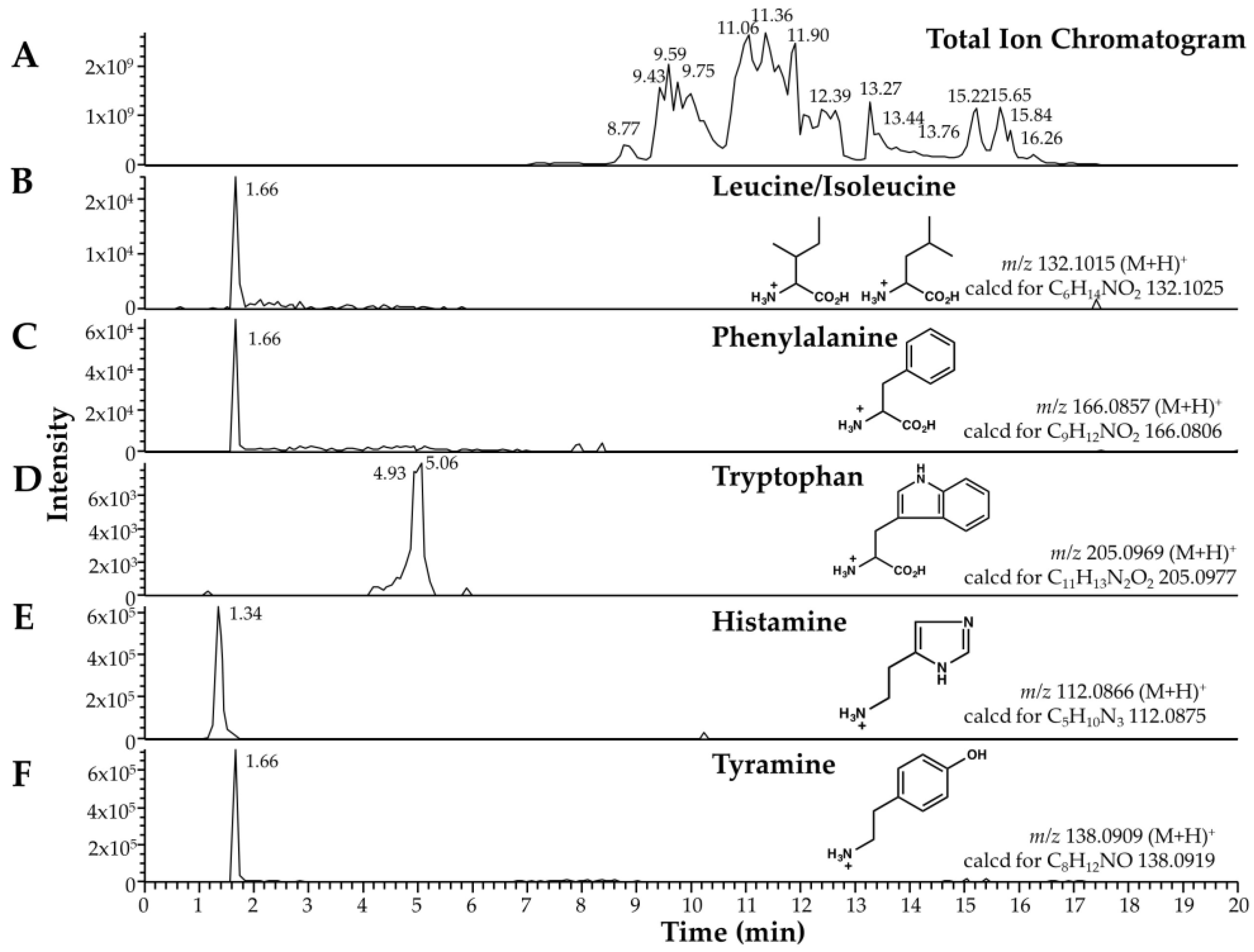
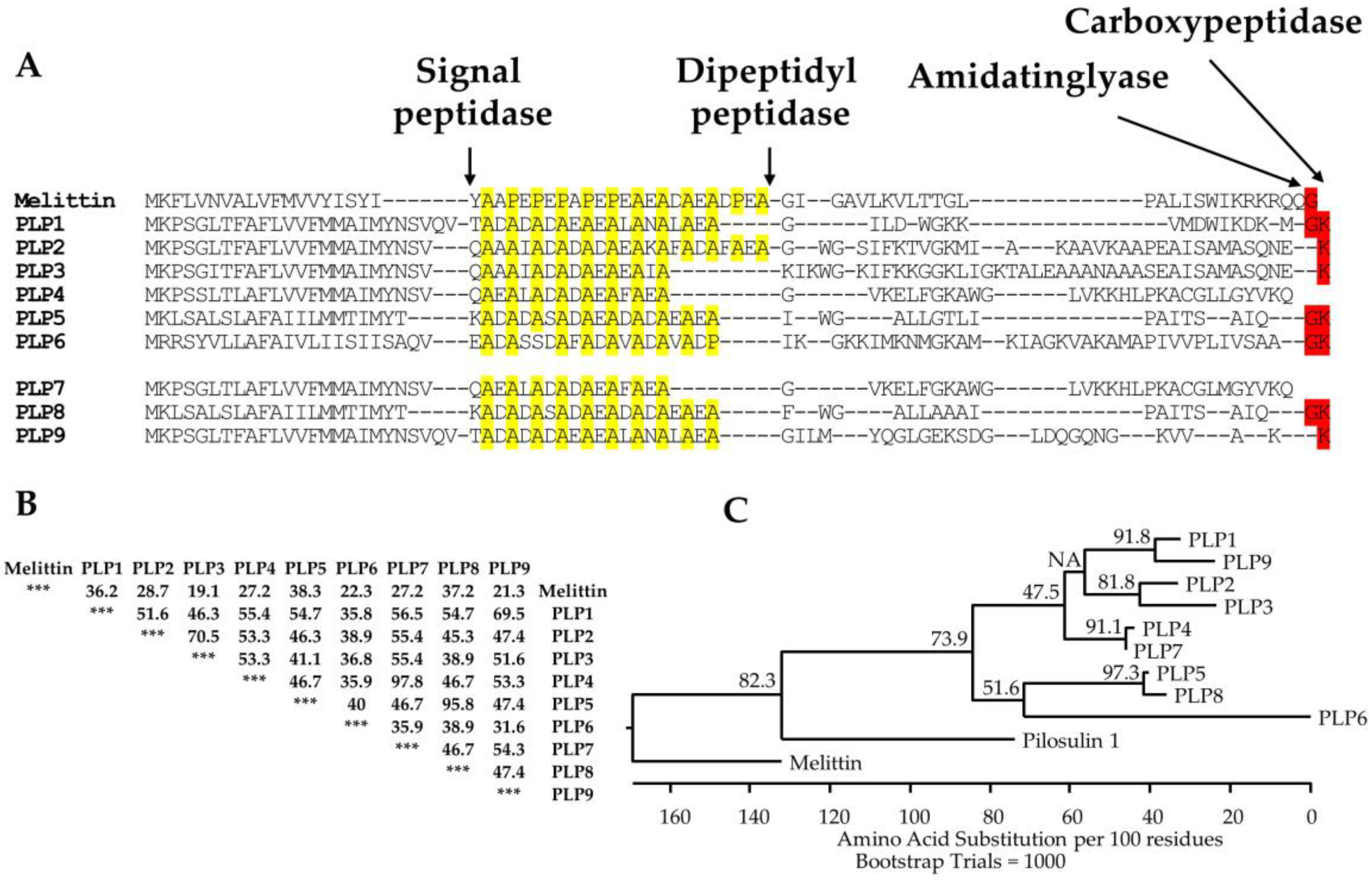
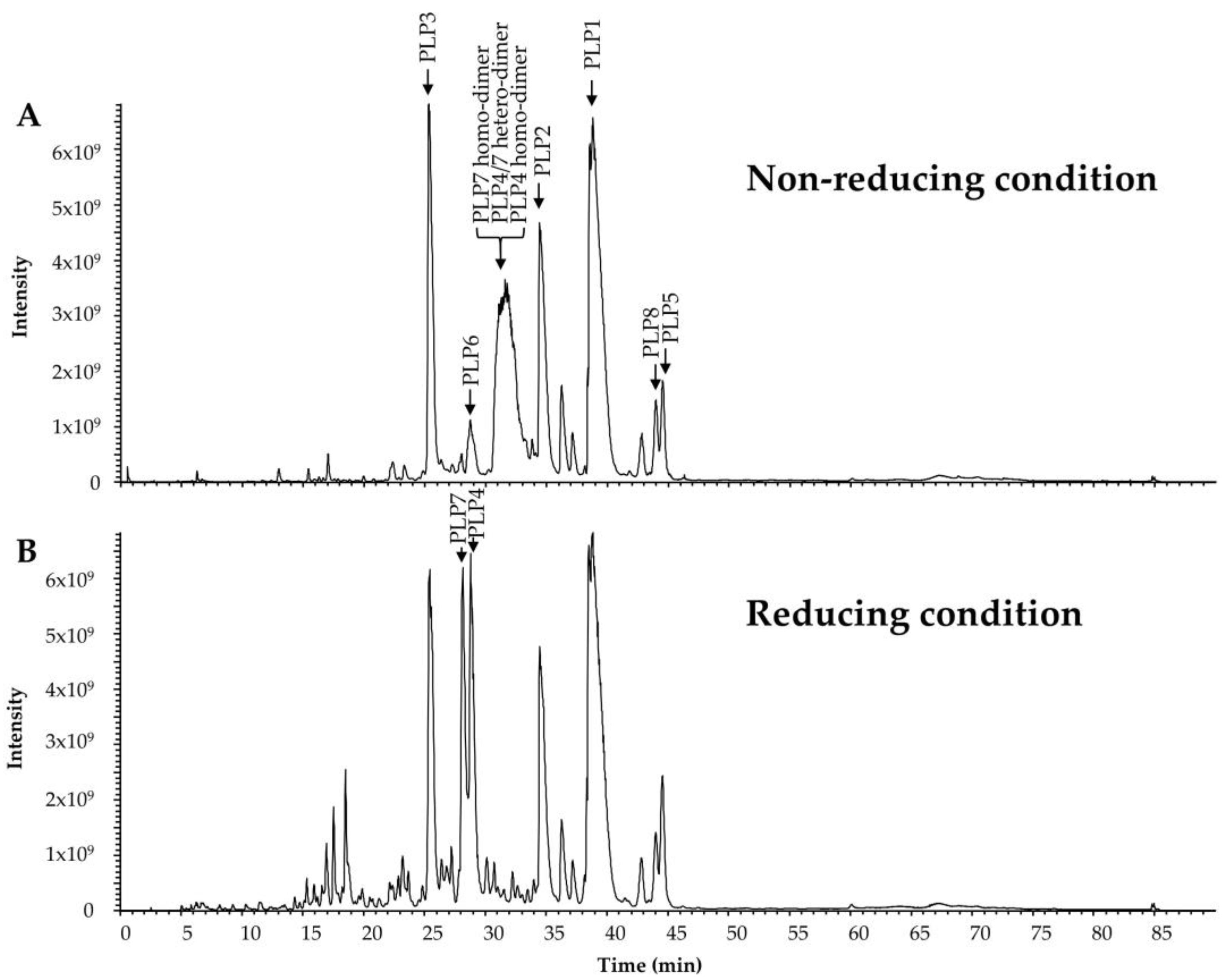
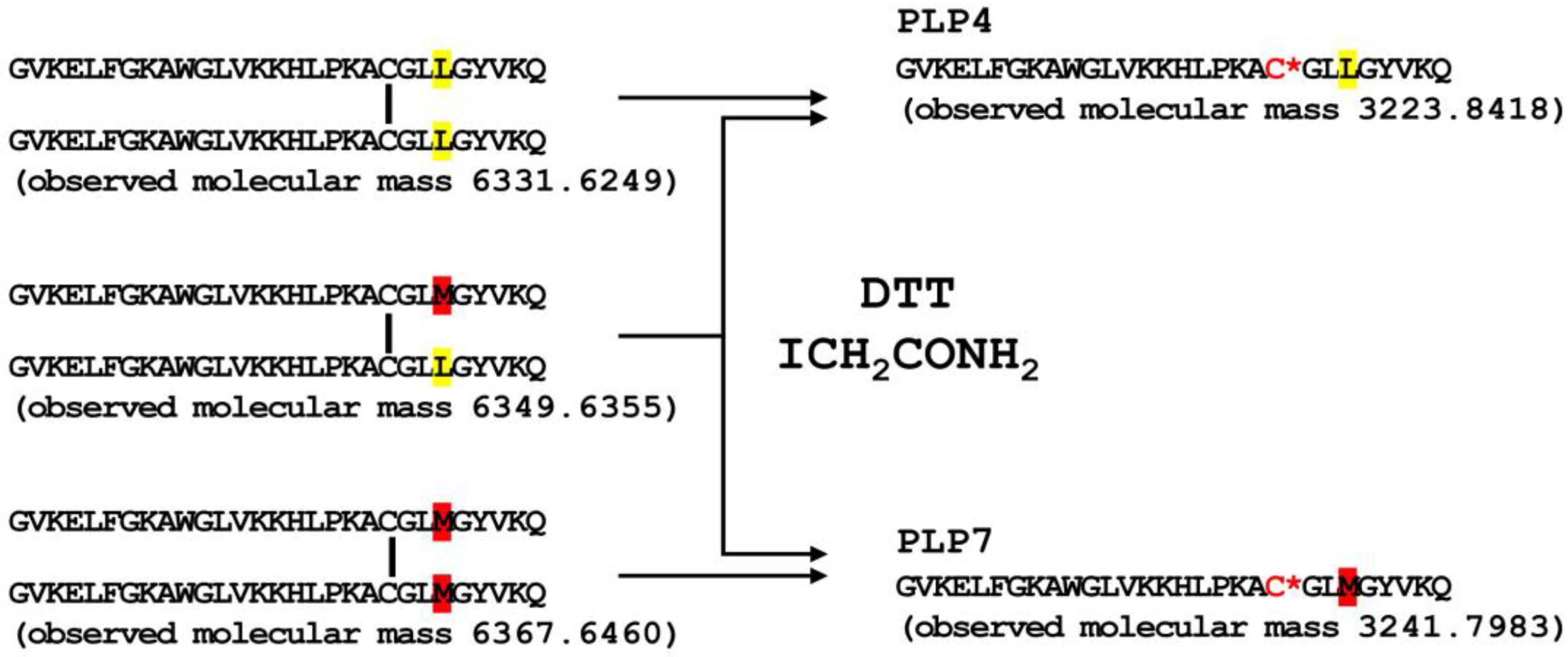
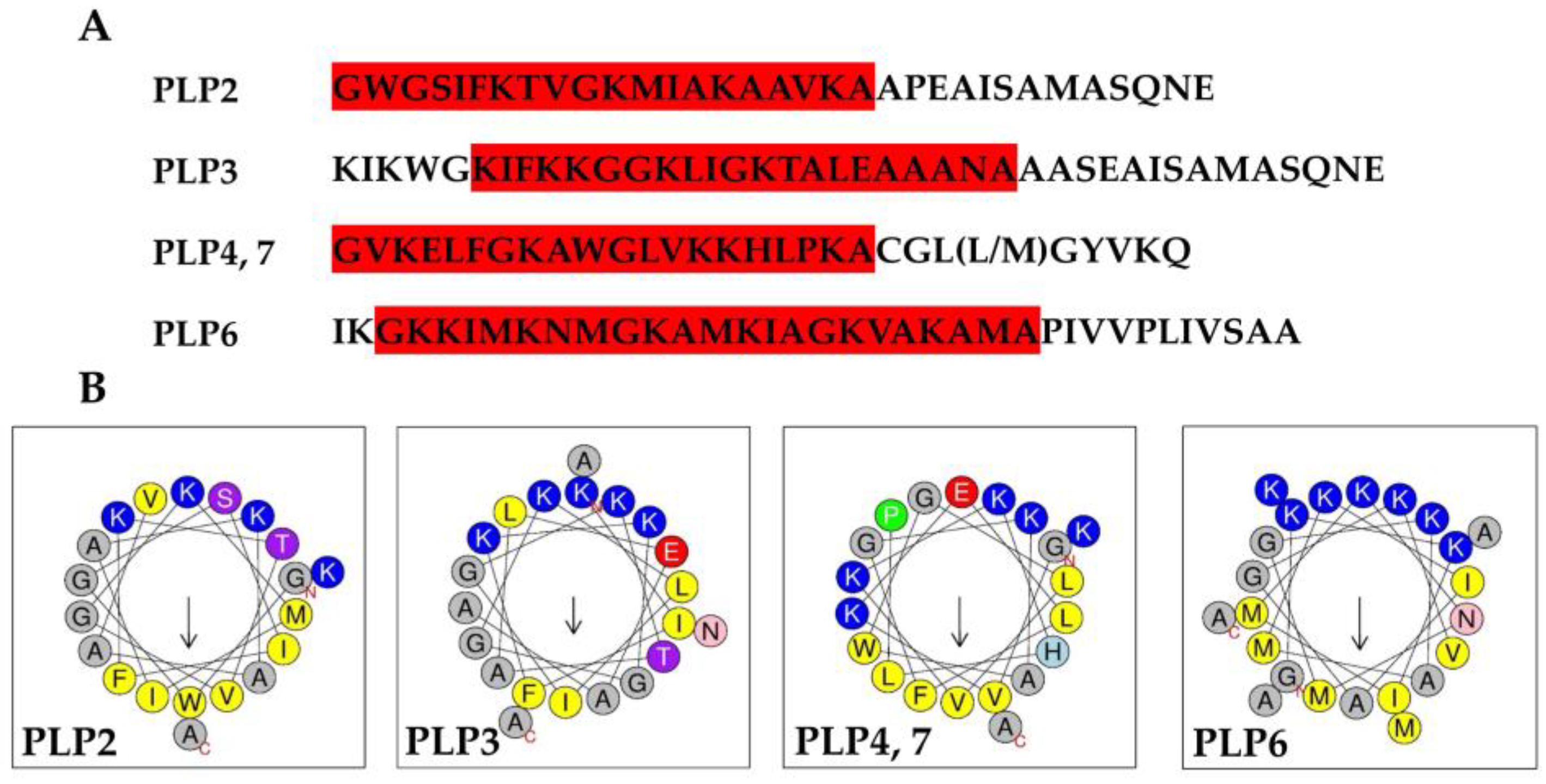
| Peptide/Protein | Accession Number | Coverage (%) a | |||
|---|---|---|---|---|---|
| TR b−, DTT b− | TR−, DTT+ | TR+, DTT− | TR+, DTT+ | ||
| acetylcholine esterase | FX985608 | 1 | |||
| apolipophorin 1 | FX985561 | 2 | 4 | 8 | 7 |
| apolipophorin 2 | FX985562 | 10 | 61 | 29 | |
| calcium-independent phospholipase A2 gamma | FX985510 | 12 | 7 | 7 | |
| carboxypeptidase D | FX985540 | 5 | 4 | 4 | |
| carboxypeptidase Q | FX985538 | 67 | 26 | ||
| CDV3 homolog | FX986049 | 8 | |||
| chymotrypsin inhibitor 1 | FX986026 | 11 | |||
| cytochrome P450 1 | FX985568 | 10 | 5 | 4 | |
| cytochrome P450 3 | FX985570 | 11 | |||
| cytochrome P450 4 | FX985571 | 4 | |||
| cytochrome P450 5 | FX985572 | 9 | 6 | 9 | |
| cytochrome P450 6 | FX985573 | 5 | 2 | ||
| cytosolic carboxypeptidase-like protein 5 | FX985541 | 4 | 7 | ||
| dishevelled homolog 3 | FX986050 | 3 | 4 | ||
| hyaluronidase | FX985505 | 5 | 68 | 47 | |
| lysosomal ProX carboxypeptidase | FX985539 | 3 | 7 | ||
| matrix metalloproteinase 14 | FX985528 | 20 | 18 | ||
| NADPH cytochrome P450 reductase | FX985574 | 5 | 6 | 5 | |
| neuroblastoma suppressor of tumorigenicity 1 | FX986056 | 7 | |||
| neuropeptide-like 1 | FX986015 | 7 | 7 | ||
| peptidyl-prolyl cis-trans isomerase 1 | FX986028 | 22 | 17 | ||
| peptidyl-prolyl cis-trans isomerase 2 | FX986029 | 4 | |||
| peptidyl-prolyl cis-trans isomerase 3 | FX986030 | 3 | 8 | ||
| peptidyl-prolyl cis-trans isomerase 4 | FX986031 | 7 | 8 | ||
| peptidyl-prolyl cis-trans isomerase 5 | FX986032 | 6 | 7 | ||
| peptidyl-prolyl cis-trans isomerase 7 | FX986034 | 1 | |||
| peptidyl-prolyl cis-trans isomerase 8 | FX986035 | 38 | |||
| pheromone binding protein 1 | FX985594 | 14 | |||
| pheromone binding protein 2 | FX985595 | 11 | |||
| pheromone binding protein 3 | FX985596 | 20 | |||
| pheromone binding protein 4 | FX985597 | 16 | |||
| pheromone binding protein 6 | FX985599 | 4 | |||
| phospholipase A2 isozyme 2 | FX985507 | 11 | 36 | 40 | |
| protein disulfide isomerase 1 | FX985548 | 8 | 14 | 8 | |
| protein disulfide isomerase 2 | FX985549 | 19 | 8 | ||
| royal jelly protein | FX986021 | 9 | |||
| UDP glucuronosyltransferase 2C1 | FX986048 | 14 | 4 | ||
| uncharacterized protein 1 | FX985636 | 4 | 5 | 3 | 6 |
| uncharacterized protein 3 | FX986042 | 19 | 64 | ||
| uncharacterized protein 4 | FX986043 | 54 | 64 | ||
| UPF0518 protein | FX986054 | 4 | 3 | 3 | 2 |
| VEGF C-like protein | FX985521 | 6 | |||
| venom allergen 1 | FX985511 | 7 | |||
| venom allergen 2 | FX985512 | 5 | |||
| venom allergen 3 | FX985513 | 21 | 5 | ||
| venom dipeptidyl peptidase 1 | FX985542 | 4 | 12 | ||
| venom dipeptidyl peptidase 2 | FX985543 | 4 | 4 | ||
| venom dipeptidyl peptidase 3 | FX985544 | 10 | 3 | 5 | |
| venom serine carboxypeptidase | FX985537 | 3 | |||
| venom serine protease 2 | FX985523 | 5 | |||
| venom serine protease 3 | FX985524 | 6 | |||
| very high density protein 1 | FX985566 | 3 | 3 | 3 | 4 |
| very high density protein 2 | FX985567 | 3 | 5 | ||
| vitellogenin 1 | FX985563 | 3 | 5 | 5 | 2 |
| vitellogenin 2 | FX985564 | 10 | |||
| waprin 1 | FX985515 | 22 | |||
| waprin 2 | FX985516 | 7 | 11 | ||
| 40S ribosomal protein SA * | FX985616 | 8 | 8 | ||
| 60S acidic ribosomal protein P0 * | FX985621 | 22 | 6 | 3 | |
| 60S ribosomal protein L10 * | FX985634 | 11 | |||
| 60S ribosomal protein L3 * | FX985633 | 10 | 7 | ||
| 60S ribosomal protein L34 * | FX985627 | 16 | |||
| 60S ribosomal protein L36 * | FX985629 | 15 | |||
| 60S ribosomal protein L4 * | FX985618 | 5 | 8 | ||
| 60S ribosomal protein L6 * | FX985625 | 5 | 11 | ||
| 60S ribosomal protein L7 * | FX985622 | 12 | |||
| 60S ribosomal protein L7a * | FX985617 | 13 | |||
| 60S ribosomal protein L9 * | FX985635 | 10 | |||
| actin, muscle * | FX985587 | 13 | 7 | 7 | |
| ATPase WRNIP1 * | FX986047 | 13 | |||
| elongation factor 1-alpha * | FX985554 | 10 | 6 | ||
| elongation factor 1-beta * | FX985557 | 5 | |||
| elongation factor 1-delta * | FX985559 | 8 | 29 | ||
| elongation factor 1-gamma * | FX985555 | 20 | 8 | 2 | |
| elongation factor 2 * | FX985553 | 4 | 4 | 2 | 8 |
| elongation factor G, mitochondrial * | FX985558 | 2 | 11 | ||
| elongation factor Tu, mitochondrial * | FX985556 | 10 | 3 | ||
| histone H2A * | FX985611 | 21 | |||
| histone H3 * | FX985610 | 15 | |||
| laminin subunit alpha 1 * | FX985614 | 4 | 6 | 5 | 8 |
| laminin subunit beta 1 * | FX985613 | 3 | 3 | 9 | |
| laminin subunit gamma 1 * | FX985612 | 3 | 3 | ||
| myosin heavy chain, muscle * | FX985575 | 4 | 3 | 11 | 8 |
| myosin heavy chain, nonmuscle * | FX985578 | 2 | 1 | 4 | |
| myosin IB * | FX985586 | 11 | 13 | ||
| myosin Ie * | FX985583 | 5 | 7 | 5 | 9 |
| myosin regulatory light chain * | FX985576 | 5 | |||
| myosin Va * | FX985582 | 2 | 5 | 4 | 8 |
| myosin VIIa * | FX985580 | 5 | 6 | 5 | |
| myosin XV * | FX985581 | 5 | 5 | 3 | 6 |
| myosin XVIIIa * | FX985584 | 2 | 5 | 4 | 3 |
| resistance to inhibitors of cholinesterase 3 * | FX986036 | 5 | |||
| transcription factor A, mitochondrial * | FX985588 | 12 | |||
| transmembrane protein 214A * | FX986055 | 10 | 4 | 4 | |
| TRPA channel d, * | FX985591 | 5 | |||
| TRPM channel d, * | FX985592 | 10 | 2 | 5 | 5 |
| TRPV channel d, * | FX985593 | 3 | |||
| voltage-gated potassium channel Shaker * | FX985601 | 9 | |||
| voltage-gated sodium channel beta subunit TipE * | FX985590 | 9 | 4 | 2 | |
| voltage-gated sodium channel Para * | FX985589 | 2 | 10 | ||
| Toxin | Sequence | Molecular Mass | Length | Precursor Ion | RT | Intensity |
|---|---|---|---|---|---|---|
| PLP1 | GILDWGKKVMDWIKDKMGK | 2247.1907 | 19 | 750.0702 | 37.15 | 3.67 × 108 |
| GILDWGKKVMDWIKDKMG | 2119.0957 | 18 | 707.3729 | 38.28 | 9.58 × 109 | |
| GILDWGKKVMDWIKDKM-NH2 | 2061.0903 | 17 | 1031.5520 | 39.15 | 1.34 × 1010 | |
| GILDWGKKVMDWIKDKM | 2062.0742 | 17 | 516.5270 | 38.35 | 5.74 × 108 | |
| LDWGKKVMDWIKDKMGK | 2077.0852 | 17 | 520.2803 | 34.11 | 2.65 × 108 | |
| GILDWGKKVMDWIKDK | 1931.0338 | 16 | 483.7657 | 33.21 | 1.64 × 108 | |
| LDWGKKVMDWIKDKM-NH2 | 1890.9849 | 15 | 631.3347 | 38.44 | 1.79 × 108 | |
| PLP2 | EAGWGSIFKTVGKMIAKAAVKAAPEAISAMASQNE | 3561.8323 | 35 | 891.4648 | 36.4 | 6.36 × 108 |
| GWGSIFKTVGKMIAKAAVKAAPEAISAMASQNE | 3361.7527 | 33 | 1121.5916 | 34.85 | 6.41 × 109 | |
| SIFKTVGKMIAKAAVKAAPEAISAMASQNE | 3061.6304 | 30 | 766.4222 | 27.81 | 1.12 × 109 | |
| GWGSIFKTVGKMIAKAAVKAAPEAISAM | 2832.5393 | 28 | 709.1410 | 34.52 | 4.53 × 108 | |
| GWGSIFKTVGKMIAKAAVKAAPEAISA | 2701.4988 | 27 | 676.3826 | 33.09 | 6.43 × 108 | |
| KMIAKAAVKAAPEAISAMASQNE | 2329.2134 | 23 | 777.4113 | 17.04 | 4.98 × 108 | |
| KAAVKAAPEAISAMASQNE | 1885.9567 | 19 | 943.9856 | 15.44 | 9.06 × 108 | |
| PLP3 | KIKWGKIFKKGGKLIGKTALEAAANAAASEAISAMASQNE | 4101.2407 | 40 | 1026.3179 | 25.25 | 4.47 × 109 |
| KIFKKGGKLIGKTALEAAANAAASEAISAMASQNE | 3488.8660 | 35 | 873.2313 | 25.16 | 1.83 × 109 | |
| KIKWGKIFKKGGKLIGKTALEAAANAAASEAISAM | 3572.0276 | 35 | 894.0147 | 24.79 | 2.65 × 108 | |
| KKGGKLIGKTALEAAANAAASEAISAMASQNE | 3100.6187 | 32 | 776.1608 | 25.63 | 2.51 × 108 | |
| KGGKLIGKTALEAAANAAASEAISAMASQNE | 2972.5237 | 31 | 744.1398 | 27.22 | 2.09 × 108 | |
| GGKLIGKTALEAAANAAASEAISAMASQNE | 2844.4287 | 30 | 949.1498 | 28.73 | 5.85 × 108 | |
| KTALEAAANAAASEAISAMASQNE | 2319.1011 | 24 | 1160.5585 | 28.03 | 1.63 × 109 | |
| PLP4 | GVKELFGKAWGLVKKHLPKAC*GLLGYVKQ | 3223.8418 | 29 | 806.9683 | 28.76 | 1.14 × 1010 |
| GVKELFGKAWGLVKKHLPKAC*GLL | 2648.5352 | 24 | 663.1436 | 30.27 | 2.98 × 109 | |
| FGKAWGLVKKHLPKAC*GLLGYVKQ | 2697.5305 | 24 | 675.3940 | 20.53 | 5.56 × 108 | |
| GKAWGLVKKHLPKAC*GLLGYVKQ | 2550.4619 | 23 | 638.6231 | 18.8 | 4.34 × 109 | |
| AWGLVKKHLPKAC*GLLGYVKQ | 2365.3457 | 21 | 789.4556 | 19.93 | 6.44 × 108 | |
| GKAWGLVKKHLPKAC*GLL | 1975.1553 | 18 | 659.3927 | 17.99 | 6.76 × 108 | |
| KHLPKAC*GLLGYVKQ | 1710.9603 | 15 | 428.7475 | 16 | 1.13 × 109 | |
| PLP5 | IWGALLGTLIPAITSAIQG | 1894.0928 | 19 | 948.0541 | 43.31 | 3.50 × 108 |
| IWGALLGTLIPAITSAIQ-NH2 | 1836.0873 | 18 | 919.0532 | 44.83 | 7.46 × 109 | |
| IWGALLGTLIPAITSAIQ | 1837.0713 | 18 | 919.5428 | 42.58 | 3.75 × 107 | |
| ALLGTLIPAITSAIQ-NH2 | 1479.9025 | 15 | 740.9585 | 36.38 | 2.25 × 108 | |
| LLGTLIPAITSAIQ-NH2 | 1408.8654 | 14 | 705.4390 | 34.1 | 1.45 × 108 | |
| LLGTLIPAITSA | 1168.7067 | 12 | 585.3602 | 30.26 | 5.15 × 106 | |
| IWGALLGTLIP | 1152.6907 | 11 | 577.3530 | 38.86 | 1.34 × 107 | |
| PLP6 | IKGKKIMKNMGKAMKIAGKVAKAMAPIVVPLIVSAA-NH2 | 3704.2307 | 36 | 927.0673 | 28.61 | 1.58 × 109 |
| KIMKNMGKAMKIAGKVAKAMAPIVVPLIVSAA-NH2 | 3277.9353 | 32 | 820.4910 | 30.81 | 8.46 × 107 | |
| IKGKKIMKNMGKAMKIAGKVAKAMAPIVVPL | 3263.9561 | 31 | 816.9973 | 23.56 | 6.27 × 108 | |
| KNMGKAMKIAGKVAKAMAPIVVPLIVSAA-NH2 | 2905.7158 | 29 | 727.4368 | 30 | 2.21 × 108 | |
| GKAMKIAGKVAKAMAPIVVPLIVSAA-NH2 | 2532.5376 | 26 | 845.1871 | 29.7 | 1.46 × 108 | |
| AMKIAGKVAKAMAPIVVPLIVSAA-NH2 | 2347.4211 | 24 | 587.8628 | 31.32 | 1.60 × 108 | |
| KAMAPIVVPLIVSAA-NH2 | 1477.9054 | 15 | 739.9600 | 31.65 | 1.18 × 108 | |
| PLP7 | GVKELFGKAWGLVKKHLPKAC*GLMGYVKQ | 3241.7983 | 29 | 811.4578 | 28.54 | 4.63 × 109 |
| GVKELFGKAWGLVKKHLPKAC*GLMGY | 2886.5764 | 26 | 722.6530 | 29.82 | 5.00 × 108 | |
| FGKAWGLVKKHLPKAC*GLMGYVKQ | 2715.4868 | 24 | 679.8821 | 19.52 | 5.42 × 108 | |
| GVKELFGKAWGLVKKHLPKAC*GLM | 2666.4917 | 24 | 667.6287 | 29.1 | 2.48 × 109 | |
| GKAWGLVKKHLPKAC*GLMGYVKQ | 2568.4185 | 23 | 643.1163 | 17.44 | 4.67 × 109 | |
| LVKKHLPKAC*GLMGYVKQ | 2069.1641 | 18 | 518.2991 | 13.87 | 2.37 × 107 | |
| HLPKAC*GLMGYVKQ | 1600.8218 | 14 | 534.6163 | 16.8 | 9.41 × 108 | |
| PLP8 | FWGALLAAAIPAITSAIQG | 1870.0352 | 19 | 936.0242 | 42.69 | 2.01 × 108 |
| FWGALLAAAIPAITSAIQ-NH2 | 1812.0298 | 18 | 907.0258 | 44.13 | 2.77 × 109 | |
| GALLAAAIPAITSAIQ-NH2 | 1478.8820 | 16 | 740.4485 | 44.09 | 2.20 × 107 | |
| FWGALLAAAIPAITS | 1500.8340 | 15 | 751.4250 | 37.82 | 1.60 × 107 | |
| ALLAAAIPAITSAIQ-NH2 | 1421.8606 | 15 | 711.9372 | 32.08 | 7.32 × 107 | |
| LAAAIPAITSAIQ-NH2 | 1237.7394 | 13 | 619.8778 | 25.83 | 8.77 × 107 | |
| AAAIPAITSAIQ-NH2 | 1124.6553 | 12 | 563.3350 | 23.08 | 2.19 × 109 |
| Peptide | MIC a (μM) | Hemolytic Activity (%) | Histamine-Releasing Activity at 10 μM (%) | |||
|---|---|---|---|---|---|---|
| E. coli (NBRC 14237) | S. aureus (NBRC 12732) | S. cerevisiae (NBRC 10217) | at 10 μM | at 50 μM | ||
| PLP1 | <3.1 | <3.1 | <50 | Negative | 32.9 | |
| PLP2 | <6.2 | <6.2 | <50 | Negative | 10.4 | 30.1 |
| PLP3 | <3.1 | <25 | <50 | Negative | 37.5 | |
| PLP4 | <3.1 | <3.1 | <3.1 | Negative | 10.5 | 66.4 |
| PLP5 | <50 | Negative | Negative | 6.9 | 94.8 | 28.3 |
| PLP6 | <3.1 | <3.1 | Negative | Negative | 33.6 | |
| Magainin | <12.5 | <25 | Negative | - | - | |
| Mastoparan | - | - | - | 13.5 b | - | 31.1 b |
| Melittin | - | - | - | 100.0 b | - | 64.3 b |
© 2019 by the authors. Licensee MDPI, Basel, Switzerland. This article is an open access article distributed under the terms and conditions of the Creative Commons Attribution (CC BY) license (http://creativecommons.org/licenses/by/4.0/).
Share and Cite
Tani, N.; Kazuma, K.; Ohtsuka, Y.; Shigeri, Y.; Masuko, K.; Konno, K.; Inagaki, H. Mass Spectrometry Analysis and Biological Characterization of the Predatory Ant Odontomachus monticola Venom and Venom Sac Components. Toxins 2019, 11, 50. https://doi.org/10.3390/toxins11010050
Tani N, Kazuma K, Ohtsuka Y, Shigeri Y, Masuko K, Konno K, Inagaki H. Mass Spectrometry Analysis and Biological Characterization of the Predatory Ant Odontomachus monticola Venom and Venom Sac Components. Toxins. 2019; 11(1):50. https://doi.org/10.3390/toxins11010050
Chicago/Turabian StyleTani, Naoki, Kohei Kazuma, Yukio Ohtsuka, Yasushi Shigeri, Keiichi Masuko, Katsuhiro Konno, and Hidetoshi Inagaki. 2019. "Mass Spectrometry Analysis and Biological Characterization of the Predatory Ant Odontomachus monticola Venom and Venom Sac Components" Toxins 11, no. 1: 50. https://doi.org/10.3390/toxins11010050
APA StyleTani, N., Kazuma, K., Ohtsuka, Y., Shigeri, Y., Masuko, K., Konno, K., & Inagaki, H. (2019). Mass Spectrometry Analysis and Biological Characterization of the Predatory Ant Odontomachus monticola Venom and Venom Sac Components. Toxins, 11(1), 50. https://doi.org/10.3390/toxins11010050





